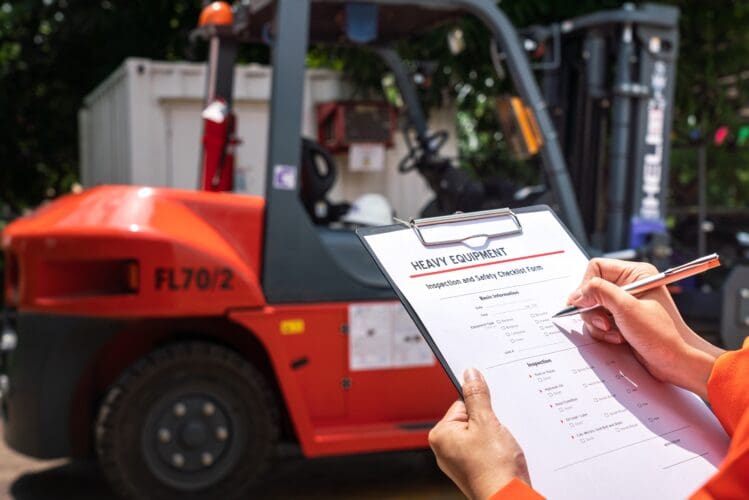In this article
Any lifting equipment used at work for lifting or lowering loads is subject to the Lifting Operations and Lifting Equipment Regulations 1998 (LOLER). Under LOLER, all operations that involve lifting equipment must be planned and supervised by a competent person to ensure they are performed safely.
The lifting equipment itself must undergo regular thorough inspections, carried out at least every 12 months, (a minimum of 6 months if used for lifting people), and these inspections must be conducted by a trained, qualified, competent person to verify that the equipment is safe to use. Any defects found must be recorded, reported and addressed before the equipment can be used. Each inspection must be detailed in a LOLER report and the inspected piece of lifting equipment must be marked with its Safe Working Load (SWL), and if it will be used to lift people, the number of people it can carry should also be marked clearly.
Maintaining accurate records of lifting equipment inspections is a fundamental aspect of health and safety management in the UK. Recorded data enables decisions to be made for health and safety improvements and records are kept in order to:
- Meet a legal requirement
- Provide evidence for enforcement agencies such as the Health and Safety Executive (HSE), employer liability insurers and in any defence against any possible litigation
Failure to maintain accurate records can be a significant violation of LOLER record-keeping requirements, and can lead to serious legal consequences, including fines and even imprisonment in serious violation cases. In this article we will examine record keeping for LOLER, and look at some best practices for LOLER record management.

What records should be kept under LOLER?
Under LOLER, it is essential to maintain thorough records of all lifting equipment examinations and inspections to ensure safety and compliance with the regulations. Regulation 11 of LOLER specifies the requirements for record-keeping, these include:
- Risk assessment – this is a detailed analysis of potential hazards associated with lifting equipment and operations. It identifies risks, assesses their likelihood and severity, identifies who might be harmed, and determines appropriate control measures to ensure safe lifting practices
- Thorough Examination Reports – these are reports detailing the results of thorough examinations including testing, of lifting equipment and lifting accessories, including specifying any defects found and any recommendations made. Under LOLER, the competent person must provide a written report of the thorough examination and tests that they do, and Schedule 1 of LOLER sets out what information must be in the report.
- Inspection in special working conditions – these examinations are only necessary if the lifting equipment and any accessories are to be used where environmental factors influence the working conditions such as where exposure to harsh weather, corrosive substances, or extreme temperatures can accelerate equipment deterioration will require more frequent inspections
- Inspection Records – these are records of regular inspections, and must include dates of the inspections, personnel involved, findings, and any recommendations made.
- Maintenance Records – these are records of maintenance activities, and include details of any repairs, modifications, and replacements.
- Defect Reports – these are records of any defects identified during inspections or examinations, along with evidence that they have been reported and addressed
- EC Declarations of Conformity – these need to be retained for the life of the equipment for any equipment meeting the requirements of the EU Machinery Directive (2006/42/EC). Following Brexit, the UK government extended recognition of this declaration indefinitely under the Supply of Machinery (Safety) Regulations 2008. However, from 1 January 2021 the new UK product marking, UK Conformity Assessed (UKCA), is required for certain goods being placed on the GB (England, Scotland, and Wales) market. UKCA started to replace the CE mark for goods sold within Great Britain and is used to demonstrate compliance with UK regulations. Lifting equipment and accessories may be displaying either the CE or UKCA marks, therefore either formats of these documents whichever is applicable, should be retained.
- Training Records – this includes all records of training provided to employees on the safe use of lifting equipment.
- Method statements – whilst LOLER does not specifically require a method statement, the regulations do mandate that lifting operations are properly planned and managed, and that safe systems of work are in place. A method statement, when used in conjunction with LOLER, can be a practical way to fulfil these requirements and ensures compliance with the regulations.
- Manufacturer’s documentation – it is always useful to retain the original manufacturer’s documentation for lifting equipment and accessories as these documents contain specifications, load capacity ratings, and any specific instructions for safe use. This crucial information supports understanding the intended purpose and ensuring the safe handling of lift equipment and accessories.
- Accident book/records – under the Reporting of Injuries, Diseases and Dangerous Occurrences Regulations (RIDDOR), any accidents causing injury must be recorded in an accident book, whilst LOLER does not specify this, any accidents involving lifting equipment must be recorded and these records retained.
The competent person is responsible for recording all risk assessments, examinations, inspections, tests performed and their outcomes such as detailing any defects found, they should also record that they have reported any defeats to the responsible person(s) and to the right authorities if applicable.
All examination reports should be presented to the responsible person, usually the employer or business owner, and if any defects have been identified, it is their responsibility to address them, rectify them, and to keep proof of the actions that they have taken to manage the risks including details of any repairs or modifications made. The employer / business owner is ultimately responsible for ensuring that all LOLER records are kept and maintained in compliance with the LOLER regulations.

How long records should be kept for?
How long LOLER records should be kept for can vary depending on the type of record, legal and regulatory requirements, industry regulations and standards, and organisational policies. However, it is an effective strategy to retain most health and safety associated records for at least five years, particularly as any potential civil legal claims for injury can be made up to three years after an incident, and records might be requested by solicitors acting on behalf of claimants, even years after the statutory need to keep records has expired. As a general rule of thumb LOLER records need to be kept for:
- Risk assessment – there is no legal time frame for keeping risk assessment records, but it is recommended to retain them for as long as they are relevant to the a particular work activity / procedure, and given that anyone who is injured can make a claim within three years they should be kept for at least three years. Risk assessments should be reviewed and updated when change occurs, such as to workforce, equipment and / or, process changes.
- Thorough Examination Reports – these records should be kept at a minimum for as long as the equipment is being used, unless an EC Declaration of Conformity or UKCA is available. Any accessory examination reports should be kept for a minimum of two years.
- Inspection in special working conditions, regular inspection, maintenance records and defect reports, the LOLER regulation requires that this information is retained until the next report is made.
- EC Declarations of Conformity or UKCA – these should be kept at a minimum for as long as the equipment is being used
- Method statements – these records should be kept at a minimum for as long as the equipment is being used and should be reviewed and updated if any changes are made to methods of use such as to operator, equipment and / or, process changes.
- Training Records – these should generally be retained for 6 years after an employee’s last date of employment.
- Accident book/records – for digital records, these must be kept for a minimum of three years after the accident, if a paper-based accident book is used, the book must be retained for a minimum of three years after the last entry was made
How to store LOLER records
Good records management and storage ensures that reports and information about activities such as LOLER inspections are easily accessible to anyone who requires them, including HSE inspectors. It also ensures that any references to personal data contained in any LOLER records such as training records, complies with the UK General Data Protection Regulation (UK GDPR) and the Data Protection Act 2018. The GDPR mandates that organisations implement appropriate security measures to protect personal data from unauthorised access, loss, or damage, meaning that adequate safeguards including for record storage are in place.
LOLER does not specify how LOLER reports and associated documents should be stored, however the regulations do specify that their storage must be secure and protected from unauthorised alteration. Neither do the regulations specify what format that records can be produced in, so records can be either paper-based and / or digital. The regulations do however state that if records are in a digital format, the system must be able to provide a written copy when necessary.
Physical storage involves using filing cabinets, offsite storage, and archival facilities. Whereas, digital storage utilises computer databases, cloud storage, and document management systems. The LOLER regulations specify that the information, or copies, should normally be stored at the premises where the lifting equipment is being used. However, in circumstances where this not possible, due to space constraints or for security reasons, then it can be stored elsewhere provided that it is readily accessible and its location is known to the person in control of the equipment.
All LOLER records must be stored in a way that enables easy access to them as LOLER records are essential for understanding the equipment’s condition and ensuring safe operations, so anyone involved in planning, supervising, or carrying out lifting operations will require access to the records. In addition, the competent person who carries out thorough the examinations and inspections of lifting equipment, will need easy access to the records to maintain a record of their work.
Health and Safety Executive (HSE) inspectors will request access to these records at any time for auditing and enforcement purposes. Should an accident occur, particularly if someone is injured and a claim is made, insurance providers and the claimant’s solicitor will also require access to the records.
Legal Requirements for Record Retention
Retaining a comprehensive record of LOLER documents is essential to ensuring compliance with legal obligations under the LOLER regulations, and in addition under the Health and Safety at Work etc. Act 1974 (HASAWA) and the Management of Health and Safety at Work Regulations 1999, RIDDOR and UKGDPR.
- LOLER Regulation 11 describes the need to retain documentation relating to thorough examinations, and declarations of conformity, and the periods of such retention.
- Section 10 of the Management of Health and Safety at Work Regulations 1999 specifically refers to record-keeping requirements for compliance with the regulations and with HASAWA.
- Under RIDDOR, employers and those in control of premises have a legal duty to report certain workplace incidents, such as work-related deaths, specified injuries, and dangerous occurrences and should retain copies of any reports made. Regulation 12 details the legal requirements of RIDDOR record-keeping.
- Article 5 of the UK GDPR outlines the legal duties placed on organisations that retain and store any personal data such as identifiable personal information in training records and / or RIDDOR reports.
Best Practices for Record Management
Following best practice in record management ensures that an organisation’s information is organised, accessible and maintained in a way that meets legal, regulatory and operational requirements, and provides a clear audit trail which enables organisations to demonstrate accountability and transparency in their operations. Let’s look at some of these best practices for record management:
- Having a records management policy that outlines how the organisation creates, manages, stores, and disposes of its records helps to clearly define the roles and responsibilities of different employees involved in record management and communicates to all employees what is expected of them regarding record management. Compliance with the policy also ensures consistency in practices, efficiency, legal and regulatory compliance, and data protection.
- Records should be arranged in a record-keeping system that will enable the organisation to ensure the quick and easy retrieval of information. The record keeping system, whether paper or digital should include a documented set of rules for classification, titling, indexing and, if appropriate, the protective marking of records. These should be easily understood to enable the efficient retrieval of information when it is needed and to maintain security and confidentiality.
- As detailed records of all inspections, including pre-use checks and thorough examinations, are crucial for demonstrating compliance with LOLER regulations, having a document version control system in place is crucial for managing changes made to any reports and other documentation. Document version control is a systematic approach to managing different versions of a document throughout its lifecycle. It involves tracking, organising, and preserving various drafts and revisions, ensuring that users know which version is current and can easily access previous versions if needed.
- Employers should have a records retention and disposal schedule based on business need with reference to statutory requirements and other principles such as industry specific regulations. The schedule should provide sufficient information to identify all records and to implement retention and disposal decisions in line with the schedule for compliance with the various legal and regulatory requirements such as those detailed above.
- It is important to choose appropriate storage options for records, whether physical or digital, and to implement secure access controls to prevent unauthorised access or damage to the records. Record, track and monitor all movement of records as records move around all the time, in and out of storage and between colleagues and work areas. Without a comprehensive cataloguing and monitoring system in place, it is easy for records to get misplaced or lost.
- Employers should consider digitising physical records to improve accessibility, efficiency, and security. They should also implement “back-up” processes as backing up records whether these are physical or digital records is crucial for data preservation and business continuity, especially in the case of equipment failure, cyberattacks, or natural disasters. A robust backup process involves creating copies of essential physical documents and / or digital files and storing them separately, typically off-site, to ensure data recovery in case of loss or corruption. Back up processes should be regularly tested and security measures should be implemented to protect backups from unauthorised access or tampering.

LOLER risk assessments and safety precautions
In planning any lifting operation, the identification and assessment of risk is key to identifying the most appropriate equipment and method for the job. A risk assessment should be carried out before carrying out a lifting process, or installing a piece of lifting equipment. A risk assessment helps identify potential hazards, evaluate the level of risk, and determine appropriate control measures to mitigate those risks. Under the Management of Health and Safety at Work Regulations (1999), the minimum a business must do is:
- Identify what could cause injury or illness in your business (hazards)
- Decide how likely it is that someone could be harmed and how seriously (the risk)
- Take action to eliminate the hazard, or if this isn’t possible, control the risk
A comprehensive LOLER risk assessment and safety plan should be tailored to each specific lifting operation, considering the unique hazards and risks involved. LOLER risk assessment considerations should include but are not limited to:
- The potential risks to people while the lifting equipment is in operation, such as parts of the lifting equipment trapping, crushing, or coming into contact with people while being operated.
- The potential risks of the equipment overturning caused by conditions such as unstable ground, insecure fixings, and ineffective counterbalances.
- The weather conditions while the lift is taking place, for example, the effect of conditions such as wind and heavy rain on the lifting equipment and load.
- Any issues that may be associated with a load of an unusual shape and if alternative measures are required to secure it while it is being lifted.
- How strong the lifting equipment is and whether it can carry the required loads, although LOLER requires all lifting equipment and accessories to be marked with their safe working load, sometimes, an item’s safe working load may need to be reduced to below its actual limit for safety reasons.
- Whether the loads may travel above and over people at any point and, if so, whether appropriate segregation is required
- Considering who may be at risk, including those who are not directly involved in the lift, as lifting operations often pose a high risk to other employees, site visitors and members of the public because they will not have received sufficient training, instructions, or warnings to make them aware of the dangers present
Risk assessment requires making a judgement on Risk Severity. Risk Severity = probability of risk materialising x impact of risk on for example a person or people, a business, a property etc.
Probability may be understood as:
- Low (Level 1) – a reasonable informed person would think it very unlikely this risk would materialise in the foreseeable future
- Medium (Level 2) – a reasonable informed person would think there is a significant possibility this risk would materialise in the foreseeable future
- High (Level 3) – a reasonable informed person would think there is a very significant or even likely possibility the risk would materialise in the foreseeable future
Impact may be understood as:
- Low (Level 1) – any impact that is minimal having regard to the importance of interests affected, impairment of function and duration. Typically, the impact is isolated and short-lived.
- Medium (Level 2) – any impact that is significant having regard to the importance of interests affected, impairment of function and duration. Typically, the impact is limited to one function or group, but there is a material operational impact and the effects may continue.
- High (Level 3) – any impact that is severe having regard to the importance of interests affected, impairment of function and duration. Typically, the impact impairs a critical function and/or has a systemic impact and the effects may be long-lasting or permanent.
Once an assessment has been made of the potential risks, who might be harmed are identified, and a judgement made on the possibility and impact of the harm occurring, the risk assessment and safety plan should detail the safety precautions taken to eliminate or control that risk.
Employers are legally required to keep employees informed about health and safety in their workplace by telling them what risks have been identified and what has been done to help protect them from those risks, so making the assessment(s) available to employees can be an efficient way of doing this.
Managing risk is an ongoing process that is triggered when changes affect work activities, changes such as but not limited to:
- Changing work practices, procedures or the work environment
- Purchasing new or used equipment or using new substances
- Workforce changes
- Planning to improve efficiency or reduce costs
- New information about the workplace risks becomes available
Risk assessments should be recorded and records regularly reviewed and updated whenever necessary and securely stored. Should an accident occur, the Health and Safety Executive (HSE) will request copies of the risk assessments.






